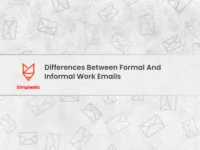Formal Apology Emails to Clients or Colleagues | Apologizing professionally via email not only demonstrates responsibility and integrity but also helps maintain constructive professional relationships. This blog presents a structured approach to articulating apologies, supplemented with practical templates and numerous examples tailored to various recipients, including clients and colleagues.
In crafting formal apology emails to clients or colleagues, adhering to a clear, structured format is vital. This outline ensures that your message conveys sincerity, responsibility, and a commitment to corrective action—a triad crucial to maintaining professional relationships and credibility. Below, find a suggested outline that embodies professionalism and clarity, indispensable qualities for effective workplace communication.
Formal Apology Email Outline
- Subject Line
- Keep it concise and indicative of the email’s content.
- Example: “Apology for [Issue]” or “Regarding Your Recent Experience with Us”
- Salutation
- Use a formal tone, addressing the recipient by their title and last name unless a first-name basis is established.
- Example: “Dear Mr./Ms. [Last Name],”
- Opening Paragraph: Acknowledgment and Apology
- Begin by acknowledging the mistake or issue directly.
- Express your sincere apology.
- Example: “I am writing to express our sincere apologies for [specific issue]. We realize that this has caused [consequence/impact], and for that, we are truly sorry.”
- Main Body: Explanation and Ownership
- Explanation (if appropriate)
- Provide a brief explanation of why the mistake happened, ensuring not to sound like you’re making excuses.
- Ownership
- Take full responsibility for the error, regardless of the specific circumstances.
- Example: “Due to [reason], [consequence] occurred. We understand that as the [your position/department], it is our responsibility to ensure that such issues do not arise, and we failed in this instance.”
- Explanation (if appropriate)
- Plan of Action
- Share the steps you are taking to correct the mistake immediately.
- Outline long-term measures being implemented to prevent recurrence.
- Example: “To address this, we have [immediate correction action]. Additionally, we are [long-term preventative measures].”
- Request for Forgiveness
- Politely ask for forgiveness or understanding, highlighting your commitment to fixing the situation.
- Example: “We kindly ask for your understanding and patience as we make these corrections. Your satisfaction and trust are paramount to us.”
- Offer of Compensation or Rectification (if applicable)
- If relevant and possible, offer a form of compensation or a gesture to make amends.
- Example: “To demonstrate our commitment to rectifying this mistake, we would like to offer you [compensation].”
- Closing Remarks
- Reiterate your apology and thanks for the recipient’s understanding.
- Encourage them to share any further feedback or concerns.
- Example: “Once again, we apologize for any inconvenience this may have caused. Please do not hesitate to reach out for further discussion or if you have any more concerns.”
- Signature
- Close with a professional sign-off.
- Include your full name, title, and contact information.
- Example: “Sincerely, [Your Name] [Your Position] [Your Contact Information]”
Key Considerations for Formal Apology Emails to Clients or Colleagues
- Tone: Ensure the tone throughout the email is professional, sincere, and empathetic.
- Brevity: While being thorough, aim to keep the email concise to respect the recipient’s time.
- Clarity: Make your explanation and actions clear, avoiding jargon or overly complex language.
- Action-Oriented: Emphasize the steps being taken to resolve the issue, demonstrating proactivity and a focus on solutions.
This structured approach to crafting a formal apology email emphasizes professionalism, responsibility, and a dedication to constructive resolution. By following this outline, you can effectively communicate your sincerity and commitment to maintaining trust in your professional relationships.
Formal Apology Emails to Clients or Colleagues
Example Emails
Below are professional apology emails, divided into three categories: directed towards clients, directed towards colleagues, and general apologies.
Directed Towards Clients
- “I would like to sincerely express my apologies for the recent oversight in our service. I understand that it may have caused some inconvenience to you and that is the last thing we intended. We are doing everything in our power to correct this issue and ensure that it does not reoccur.”
- “In reviewing our recent interactions, I realize that we did not meet the high standards we set for ourselves and the ones you expect from us. This mistake rests solely on our shoulders and we accept full responsibility. Our team is working diligently to rectify this situation and ensure it is not repeated.”
- “We are aware of the issue you faced and I want to personally apologize for our lapse in service. Our priority is to rectify this situation promptly and instill steps to prevent such occurrences in the future. Your patience and understanding in this matter are greatly appreciated.”
Directed Towards Colleagues
- “I am reaching out to acknowledge and apologize for overlooking the crucial information you provided. This oversight negatively influenced the end result. I am currently recalibrating my approach to ensure it does not repeat.”
- “I understand that my delay in submitting the required data has put a strain on our project timeline. I sincerely apologize for this and am making all necessary efforts to catch up and reallocate resources to meet the pending deadlines.”
- “It has come to my attention that an error in my recent report has caused some confusion. I sincerely regret this and am taking immediate actions to correct the information and recalibrate our strategy based on accurate data.”
General Apologies
- “I did not live up to the expectations I have set for myself and I deeply regret its impact on our interaction. Rest assured, I have learned from this lapse and am making necessary adjustments to ensure it does not happen again.”
- “I understand my recent actions may have caused undue stress. Please accept my sincerest apologies as I strive to correct this situation. Your understanding is greatly appreciated as I work towards a resolution.”
- “I wanted to apologize for the confusion during our last meeting. I acknowledge that better preparation on my part could have prevented it. Steps are being taken to ensure clarity in our future interactions.”
- “Upon reflection, I understand my approach to the recent project was not as efficient as it should have been, affecting our results. I sincerely regret this and am revisiting my strategies to improve future outcomes.”
- “It’s important for me to communicate that my recent error in judgment has brought forward lessons that I hope to learn from. I am wholeheartedly committed to amending any issues that have arisen as a result.”
- “My actions in our last encounter failed to demonstrate the respect and collaboration we value in our organization. I extend my sincere apologies for this oversight and assure you of my dedicated efforts to foster positivity and unity henceforth.”
- “I realize my error added to our workload and created unnecessary complications. I apologize sincerely for this misstep and am channelling all my efforts into expediting our operations.”
- “The mistake I made is against the professionalism we uphold in our line of work. I deeply apologize for this and am collaborating with stakeholders to amend the situation.”
- “I wanted to extend a sincere apology for the miscommunication in our recent correspondences. I understand the confusion it caused and am taking steps to ensure clearer, more effective communication moving forward.”
Formal Apology Emails to Clients or Colleagues | Template Emails
Formal Apology Emails Directed Toward a Client
Template 16: Subject: Acknowledgment of Our Mistake and Steps Forward
Dear [Client’s Name],
I am reaching out to acknowledge an oversight in [specific detail of the mistake]. We understand the inconvenience caused and sincerely apologize. To address this, [solution]. We assure you of our commitment to [steps to prevent future mistakes]. We value your trust and hope to move forward with a renewed focus on delivering excellence.
Sincerely,
[Your Name]
Directed Towards a Client
Template 17: Subject Line: Sincere Apologies for Delay in [Service/Product Delivery]
Dear [Client’s Name],
I hope this message finds you well. I am writing to you directly to extend our sincerest apologies for the delay in delivering the [specific service/product] you were expecting on [expected date]. We understand that this has likely caused inconvenience and may have impacted your plans or operations.
Upon investigating the cause of this delay, we have identified [briefly mention reason, if appropriate and without placing blame] and are taking the following steps to ensure this does not happen in the future:
[Implementing a new tracking system for better service oversight]
[Enhancing our communication protocols to keep you informed of progress]
To rectify our oversight, we are [mention any compensation, expedited delivery, discount, etc., if applicable]. We value your trust and business, and are committed to restoring your confidence in our services.
Thank you for your understanding and patience. We are dedicated to resolving this matter to your satisfaction as swiftly as possible.
Kind Regards,
[Your Name]
[Your Position]
[Your Contact Information]
Template 18: Subject Line: Our Apologies for Not Meeting Your Expectations
Dear [Client’s Name],
I am reaching out to you personally to express our regrets for not meeting the high standards of service we pride ourselves on, and that you anticipated, particularly regarding [state the specific issue].
It is crucial for us to learn more about your experience so we can undertake the necessary improvements. Listed below are actions we are already implementing to address your concerns:
[Immediate review of the service protocol]
[Focused training sessions for our team]
We are also prepared to [mention specific offer, e.g., provide a complementary service, issue a refund, etc.], reflecting our commitment to your satisfaction and as an assurance of our dedication to quality.
Please let us know a convenient time for a call to discuss how we can make amends and move forward positively. Your feedback is invaluable.
Warmest Regards,
[Your Name]
[Your Position]
[Your Contact Information]
Template 19: Subject Line: Addressing Our Miscommunication – Our Apologies
Dear [Client’s Name],
With utmost respect, we acknowledge a breakdown in communication during our recent interaction, specifically regarding [describe the situation briefly]. It was never our intention to create any confusion or inconvenience, and we truly apologize for any frustration that may have occurred as a result.
We have taken this matter seriously and are implementing measures to enhance our communication, such as: [Introducing a client communication liaison]
[Adopting a new protocol for client updates]
Your satisfaction and trust are paramount to us. To address the impact of this miscommunication, we would like to offer [state the resolution, whether it’s a meeting, a discount, additional services, etc.].
We are here to ensure that your experience with our service improves moving forward. Please do not hesitate to share further concerns or suggestions you might have.
Thank you for your understanding, and once again, we apologize for any inconvenience caused.
Sincerely,
[Your Name]
[Your Position]
[Your Contact Information]
Formal Apology Emails Directed Toward a Colleague
Template 20: Subject: Apology for [Brief Description of Incident]
Dear [Colleague’s Name],
I realize my actions in [context] may have [consequence]. It was not my intention to [effect], and I am truly sorry. To remedy this, I propose [solution or suggestion]. Your feedback would be greatly appreciated.
Thank you for understanding,
[Your Name]
Template 21: For Missing a Deadline
Subject: Apology for Missing [Specific Deadline]
Dear [Recipient’s Name],
I acknowledge that I missed the [specific deadline], which is not in line with our standards. I apologize for any disruption this may have caused. I am currently [solution/action taken]. To prevent this in the future, [preventative measure]. I appreciate your patience and understanding.
Best regards,
[Your Name]
Template 22: Subject Line: Acknowledging My Misstep in [Specific Situation]
Dear [Colleague’s Name],
I hope this message finds you well. I am writing to extend my sincerest apologies for my mistake in [specific detail about the mistake]. I realize that this may have caused inconvenience or disruption, and for that, I am truly sorry.
My intention was always to support our shared objectives and I understand that my oversight was counterproductive. Rest assured, I have taken necessary measures, such as [mention what you are doing to correct your mistake and avoid it in the future], to amend this situation and prevent any recurrence.
I appreciate your understanding in this matter and I look forward to continuing our collaboration with renewed focus and precision.
Best Regards,
[Your Name]
[Your Position]
Template 23: Subject Line: Sincere Apologies for Missed Deadline on [Project/Assignment name]
Dear [Colleague’s Name],
I wanted to personally apologize for failing to meet the recent deadline for the [specific task/project]. I understand that this delay could have put unnecessary pressure on you and the rest of the team.
This occurrence was due to unforeseen circumstances that diverted my resources and attention. I am already working to mitigate these issues and ensure they do not affect our timely progress in the future. As part of this, I am [describe any specific steps you are taking].
Thank you for your patience and understanding as we navigate this hurdle together. I am committed to making it right and getting our project back on schedule.
Sincerely,
[Your Name]
[Your Position]
Template 24: Subject Line: Apologies for the Miscommunication Regarding [Project/Task name]
Dear [Colleague’s Name],
I want to express my regret over the confusion caused by my previous emails/messages regarding [specific issue]. I didn’t articulate my ideas clearly, leading to misunderstandings.
To ensure this doesn’t happen again, I am going to [describe some actions or strategies you’ll implement for better communication, including clarifying any ambiguity and answering any questions promptly.]
Taking this experience as a constructive lesson, I strive for straightforward communication in all future correspondences. Please feel free to share any concerns or suggestions you might have.
Thank you for your understanding and collaboration.
Best regards,
[Your Name]
[Your Position]
Template 25 Subject Line: Apology for Delay in Project Report Submission
Dear [Recipient’s Name],
I am writing to apologize for the delay in submitting the project report originally scheduled for delivery on [date]. I understand that this delay may have impacted your planning and workflow, for which I am sincerely sorry.
The delay was due to unforeseen challenges in data aggregation that required additional verification to ensure the accuracy of our findings. I take full responsibility for not allocating extra time for such potential obstacles.
To address the current delay, I am dedicating additional resources to complete the report. We now expect to deliver it by [new date]. To prevent future delays, we have revised our project timeline estimation process to include buffer times for unforeseen tasks.
I kindly ask for your understanding and patience as we work through these changes to improve our delivery process.
Please feel free to reach out if there are any questions or further information required. Thank you for your patience and understanding.
Sincerely,
[Your Name]
[Your Position]
[Your Contact Information]
Formal Apology Email | 25 Key Phrases
Apology Phrases Directed Towards Clients
- “I acknowledge the inconvenience my error may have caused and am committed to making it right.”
- “We stumbled, but we’re here to ensure it’s made right.”
- “Your satisfaction is paramount to us, and we are actively taking steps to ensure this issue is resolved to your satisfaction.”
- “It’s with our sincerest apologies that we reach out to make amendments for our recent service lapse.”
- “We’re committed to excellence and fell short. Here’s how we’re fixing it.”
Apology Phrases Directed Towards Colleagues
- “I missed mark on this, and I am taking steps to ensure it doesn’t happen again.”
- “My recent oversight impacted our project, and for that, I am sincerely sorry.”
- “In my eagerness to deliver, I overlooked a crucial detail. Here’s how I plan to address it.”
- “I underestimated the time required, affecting our schedule. I’m exploring solutions to expedite our progress.”
General Apology Phrases
- “I regret the misunderstanding and am eager to clarify to move forward effectively.”
- “Mistakes offer us the chance to learn and improve. Here’s the lesson I’ve taken.”
- “A miscommunication led to confusion, and for that, I am sorry. Let’s clarify and progress.”
- “Oversights are part of growth. I am working on measures to prevent a recurrence.”
- “I appreciate your patience as we navigate this setback. Your support means a great deal.”
- “Our aim is to provide the highest quality service, and we’re taking steps to ensure this.”
- “In recognizing our error, we’re implementing improvements immediately.”
- “We missed an opportunity to excel due to our oversight, and for that, we apologize.”
- “Immediate actions are being taken to correct our course and exceed your expectations henceforth.”
- “This experience has provided valuable lessons, and we’re grateful for your understanding as we improve.”
- “Let’s view this as a stepping stone to greater efficiency and collaboration.”
Read more:
M





